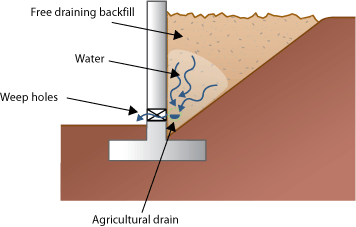Construction requirements
All types of retaining walls require a system to minimise the build up of water pressure exerted upon the retaining wall by the water contained within the soil. This pressure is called 'hydrostatic pressure'.
Minimising hydrostatic pressure can be achieved by carefully controlling the backfill that is placed behind the retaining wall. It must be a coarse, well draining material such as scoria Scoria is a type of volcanic rock. It is relatively light rock because of its many holes and is usually a reddish brown colour..

An agricultural drain placed behind the wall within the free draining backfill will help drain the water away to the stormwater drainage system. A series of weep holes in the base of the wall will also minimise the effects of hydrostatic pressure exerted upon the wall.

In some cases retaining walls form the external wall of a building and therefore must be adequately sealed to prevent moisture entering the building. This is achieved by applying 'tanking' which is a waterproofing system that incorporates waterproof membranes.
